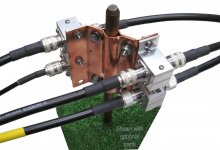KQ4RBK
Member
Hi all,
New ham here. Trying to get my HF station set up and have a grounding question. I have tried to research things as much as I can but am stuck on the shack/RF grounding.
My shack is located in my office on one side of the house. Antenna is a dipole located off of the other side of the house. The coax from the dipole goes down to a lightning arrestor/surge protector mounted to an 8' ground rod right outside the house. It is along the same wall as the main utility panel, so I have the antenna ground rod bonded to the main house ground rod about 12' away. From there the coax goes about 50' through the exterior wall, up into the attic, across the house, and back down through the wall into my office shack.
Now I am trying to figure out how to ground the equipment in the shack. I have mounted a piece of 1/2" copper pipe to the back of my desk, and am going to connect all equipment chassis grounds to it using 1/2" copper braid. My question is, how do I now ground the copper pipe? My options as I see them are:
1. Drill a hole through the exterior wall of my office, and put another ground rod right outside to connect the copper pipe to. However, it would be very difficult to bond this back to the utility ground as it is on the opposite side of the house, and would have to cross a concrete driveway. My understanding is that code would require it to be bonded, but I don't know how to make that happen without many more ground rods and copper wire in between along with demoing the driveway...
2. Somehow (?) connect it to a ground wire inside of one of the electrical outlets in the office. This would connect it back to the house circuit breaker panel which is then tied back to the house ground. But everything I have read says you want "short, thick, or braided cable" to the ground rod. This connection would be to the 12awg (?) romex ground wire that would be neither short, thick or braided.
3. Run an additional ~50' wire or braid back up through the attic alongside the coax that ties back to the antenna ground on the other side of the house. Neither short, nor cheap.
4. Connect the equipment to the copper pipe as planned and then don't connect that to ground.
5. Do nothing and don't worry about it.
None of these options really seem ideal. Am I missing something?
Thanks!
KQ4RBK
New ham here. Trying to get my HF station set up and have a grounding question. I have tried to research things as much as I can but am stuck on the shack/RF grounding.
My shack is located in my office on one side of the house. Antenna is a dipole located off of the other side of the house. The coax from the dipole goes down to a lightning arrestor/surge protector mounted to an 8' ground rod right outside the house. It is along the same wall as the main utility panel, so I have the antenna ground rod bonded to the main house ground rod about 12' away. From there the coax goes about 50' through the exterior wall, up into the attic, across the house, and back down through the wall into my office shack.
Now I am trying to figure out how to ground the equipment in the shack. I have mounted a piece of 1/2" copper pipe to the back of my desk, and am going to connect all equipment chassis grounds to it using 1/2" copper braid. My question is, how do I now ground the copper pipe? My options as I see them are:
1. Drill a hole through the exterior wall of my office, and put another ground rod right outside to connect the copper pipe to. However, it would be very difficult to bond this back to the utility ground as it is on the opposite side of the house, and would have to cross a concrete driveway. My understanding is that code would require it to be bonded, but I don't know how to make that happen without many more ground rods and copper wire in between along with demoing the driveway...
2. Somehow (?) connect it to a ground wire inside of one of the electrical outlets in the office. This would connect it back to the house circuit breaker panel which is then tied back to the house ground. But everything I have read says you want "short, thick, or braided cable" to the ground rod. This connection would be to the 12awg (?) romex ground wire that would be neither short, thick or braided.
3. Run an additional ~50' wire or braid back up through the attic alongside the coax that ties back to the antenna ground on the other side of the house. Neither short, nor cheap.
4. Connect the equipment to the copper pipe as planned and then don't connect that to ground.
5. Do nothing and don't worry about it.
None of these options really seem ideal. Am I missing something?
Thanks!
KQ4RBK


